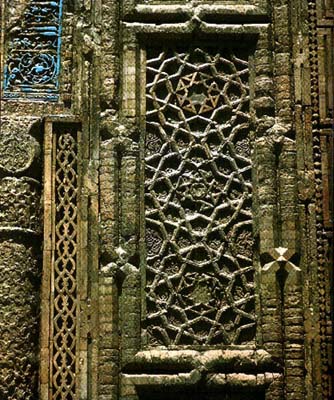 Back
east, beyond the art museum but before the next covered market, Central
Asia's oldest mosque stands among trees on the north side of the street.
Magok-i-Attari was half buried when the Russian archaeologist Shishkin
got to it in 1939 after excavating the Samanids' mausoleum. He revealed
its most precious component, a 12th-century south-facing portal with immaculate
incised alabaster panels, but also found traces
of a 5th-century Zoroastrian temple and an even earlier Buddhist one. People
have worshipped most things here at one time or another, including the
moon. In pre-Arab times it served as a herbalists' bazaar selling idols
and drugs as well as herbs and spices. A fire destroyed whatever stood
here in 937. The first mosque went up in the 11th century; a new one, built
in the 12th, was ruined bar the south portal by the 15th. Most of what
survives dates from a comprehensive restoration carried out in 1546-7.
The brickwork of the east portal seems to imitate that of the Samanid mausoleum. Back
east, beyond the art museum but before the next covered market, Central
Asia's oldest mosque stands among trees on the north side of the street.
Magok-i-Attari was half buried when the Russian archaeologist Shishkin
got to it in 1939 after excavating the Samanids' mausoleum. He revealed
its most precious component, a 12th-century south-facing portal with immaculate
incised alabaster panels, but also found traces
of a 5th-century Zoroastrian temple and an even earlier Buddhist one. People
have worshipped most things here at one time or another, including the
moon. In pre-Arab times it served as a herbalists' bazaar selling idols
and drugs as well as herbs and spices. A fire destroyed whatever stood
here in 937. The first mosque went up in the 11th century; a new one, built
in the 12th, was ruined bar the south portal by the 15th. Most of what
survives dates from a comprehensive restoration carried out in 1546-7.
The brickwork of the east portal seems to imitate that of the Samanid mausoleum.
 The
south entrance, approached by stone steps, is now 5 m below ground level
and was always sunken: magok means 'in a pit'. Most of the interior now
houses a carpet exhibition but the brick-lined pits on the east side go
down to Shishkin's Buddhist depths. The chai-khana opposite Magok-i-Attari
occupies the 20th-century Sarrafan mosque and the dome over Ulitsa Lenina
beyond it belongs to Taq-i-Sarrafan, the moneychangers' bazaar. The
south entrance, approached by stone steps, is now 5 m below ground level
and was always sunken: magok means 'in a pit'. Most of the interior now
houses a carpet exhibition but the brick-lined pits on the east side go
down to Shishkin's Buddhist depths. The chai-khana opposite Magok-i-Attari
occupies the 20th-century Sarrafan mosque and the dome over Ulitsa Lenina
beyond it belongs to Taq-i-Sarrafan, the moneychangers' bazaar.
[back]
|

